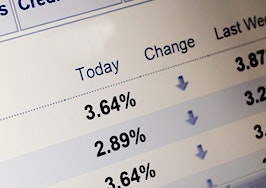- The signals and economic effects are all in bonds, which have been rising this week.
- Trump’s election was a catalyst for a tectonic move already underway.
Consider the wreck in the bond market. Ignore stocks. In this circumstance they have neither predictive nor economic power. The signals and economic effects are all in bonds.
On the morning of Election Day, the 10-year T-note traded 1.83 percent. The day after: it opened at 1.95 percent and closed the day at 2.07 percent. Thursday: 2.15 percent, the highest since January. Today, a holiday. Thank heavens. Mortgages have barely held 4.00 percent.
The two obvious questions: Did Trump’s election really do this? And how far does it have to run? Quick answer to the latter: In the “Taper Tantrum” after Bernanke announced the end to QE quantitative easing), the 10-year ran from 1.60 percent to 3.00 percent in a straight line.
An upward move in long-term rates began this June, after the 10-year’s 1.37 percent revisit to the all-time low. The move up has been gradual, but steepening.
Everyone saw the bearish signs, but with little inflation, a non-accelerating economy, the Fed arguing about a single 0.25 percent rate hike, and the world a mess, what’s to worry about? The bond market had been defiant of all Fed threats for four years and gotten away with it.
But, back there in late summer when “President Trump” was an unthinkably bad joke (not in all of the U.S., as we have learned, but in global markets) — something else was up. The BOJ (Bank of Japan) and ECB (European Central Bank) in different ways but simultaneously acknowledged that a near-decade of zero-percent rates had failed to ignite global economies, and that the experiment with negative rates had been a counterproductive bust.
The last resort of the central banks: punt to fiscal stimulus. Spend and borrow and the central banks will monetize (more). Encourage inflation to rise (less in the U.S.), and higher rates, and bet the spending will boost economies more than higher rates hurt.
We have tried this before. The epic precursor was Reagan’s first year, the first modern experiment with “supply side” tax cuts and massive deficits. That “voodoo” idiocy occupied the rest of Reagan and all the way to Clinton with tax increases to repair the damage.
We voodooed again in Dubya’s first year, and ever since have pasted together tax increases in trade for spending ceilings.
Each time the economy got more temporary growth from spending than it lost from higher rates, but this world is different. This world is drowning in overcapacity and faces unprecedented global aging.
I don’t know anything beneficial in higher inflation or rates. New spending (no matter on what) will tend to wash right out of the patient.
It’s going to happen, though. Trump’s election was a catalyst for a tectonic move already underway. Global markets look like ours, rates and commodity prices spiking.
But, why? Little in U.S. politics has changed. Trump got the same number of votes as Romney, but was elected because the Obama majority in 2012 did not turn out for Hillary. Sure, some who voted for Trump had not voted for Romney, and vice-versa, but quibbling.
Congress has the same balance — and imbalance among Republicans.
Two things changed on Tuesday (economic things). First, Mr. Trump is a do-er. We have not had a do-er since Bill Clinton, and before that, Ron Reagan.
Dubya was a foreign policy do-er, unfortunately. Obama never discovered the difference between thinking and talking about thinking, and doing.
Markets for 15 years have been in a comfortable and predictable cocoon of gridlock. On Tuesday we set a new pool table, and broke the racked balls with a howitzer.
Limiting the extent of change ahead: Mr. Trump will soon discover how hard it is to get anything done (Jack Kennedy’s lament). And another difficulty: Before he’s inaugurated, someone will show to him the real budget numbers, the un-funded out-year explosion in entitlement spending, which will confine any tax cuts or new spending.
The second change: Trump brings with him sudden and fantastic uncertainty about the Fed. Yellen, Vice Chair Fischer and supporting governor Tarullo have barely a year left in their terms. Of seven governor seats, two have been empty because of Senate obstruction.
Thus in a year, Trump will install five of the seven. And their plans…?
Every aspect of this is disturbing to bonds, and that means sell.
The 10-year T-note in the last week. Cause and effect are impossible to deny.
The 10-year in the last year. Note that this week it blew right through five months of solid support in springtime at 1.85 percent.
The 10-year five years back. Note the all-time low in 2012, and then the Taper Tantrum. We did fall back down out of that tree, but nearly touched 5.00 percent for mortgages, and it required time, a slow U.S. economy, and the deepening mess overseas.
The 2-year T-note is the best of all Fed predictors. Its relatively calm reaction this week is the one indicator that the bond market is overdone.
Lou Barnes is a mortgage broker based in Boulder, Colorado. He can be reached at lbarnes@pmglending.com.
















